
Friction, coefficient of friction-A level physics

Solid friction
Friction is the forces that oppose the relative motion of two surfaces in contact.
The direction of the friction force is opposite to the direction of motion of the body.
Types of friction
There are 2 types of friction i.e.
(i) Static friction
(ii) Kinetic friction / sliding friction
Static friction opposes the tendency of one body sliding over the other.
Kinetic/sliding/dynamic friction opposes the sliding of one body over the other.
Limiting friction is the maximum friction between on two surfaces.
Laws of solid Friction
- The frictional force between two surfaces opposes their relative motion.
- The frictional force is independent of the area of contact of the given surface when the normal reaction is constant.
- The limiting frictional force is proportional to the normal reaction for case of static friction. The frictional force is proportional to the normal reaction for the case of kinetic (dynamic) friction and is independent of the relative velocity of the surfaces
Molecular Theory and the laws of solid friction
On a microscopic level, even a highly polished surface has bumps and hollow. It follows that when 2 surfaces are put together, the actual area of contact is less than the apparent area of contact.

At points of contact like a, b, c, small cold-welded joints are formed by the strong adhesive forces between the molecules in the two surfaces.
These joints have to be broken before one surface can move over the other.
This accounts for law 1.
The actual area of contact is proportional with the normal force (reaction). The frictional force which is determined by the actual area of contact at the joints is expected to be proportional to the normal force.
This accounts for law 1 and 3
If the apparent area of contact of the body is decreased by turning the body so that it rests on one of the smaller side, the number of contact points is reduced. Since the weight of the body has not altered, there is increased pressure at the contact points and this flattens the bumps so that total contact area and the pressure return to their original values. Therefore, although the apparent area of contact has been changed, the actual area of contact has not.
This accounts for law 3
Coefficient of static friction
Coefficient of limiting friction is proportional to the normal reaction or it weight.

μ is known as the coefficient of friction between the two surfaces. The magnitude of μ depends on the nature of the two surfaces; for example it is about 0.2 to 0.5 for wood on wood, and about 0.2 to 0.6 for wood on metals.
Measurement of coefficient of static friction, µs
Method 1: Using a tilting plane.
A block A is placed on a plane and the plane is tilted until when the block begins to slide. The angle of θ of inclination of the plane surface to the horizontal is measured.
The co-efficient of friction is given by µs = tan θ

When the block is at the point of sliding

Method 2: To determine the co-efficient of static friction.
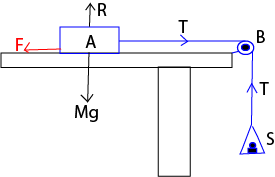
Masses are added to the scale pan until the block just slides. The total mass m of the scale pan and masses added is noted. The procedures are repeated for different values of R obtained by adding known weights to the block.
A graph of mg against R(Mg) is plotted.
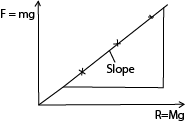
The slope of the graph is µs
Co-efficient of kinetic (dynamic friction)


A wooded block of known weight is connected to a scale pan by a string passing over a smooth pulley as shown in the diagram above.
Small masses are added to the scale pan one at a time and each time the block is given a slight push. This is repeated until the block moves with a constant speed after a light push.
At this instant, the weight of the scale pan and all masses added to it is equal to kinetic frictional force (f).
The weight of the block is equal to the normal reaction. the normal reaction is varied by adding known weights on the block at each time finding the corresponding frictional force.
The values of the normal reaction R and corresponding kinetic force (f) is recorded in the table.
A graph of F against R is plotted and its slope gives the coefficient of kinetic friction

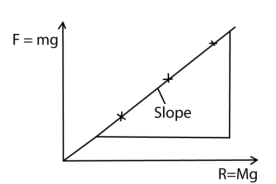
The slope of the graph is µs, is coefficient of kinetic friction
Advantage of friction
- Used in writing
- Used in movement
- Used in walking
Disadvantage of friction
- Wears machines
- Wears shoes
- Causes unnecessary noise in moving parts of a machines.
Examples 1
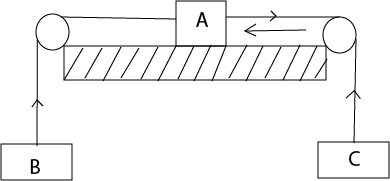
A, B, C are particles with masses 7, 5, 2kg respectively. when the system is released from rest with coefficient of friction 1/5.
Find
(a) Acceleration of the system
(b) Tension of the strings
(c) Distance moved by B after 4s
Solution
(a) Consider B
5a = 5g – T2 ……………………………..(i)
Consider C
2a = T1 -2g…………………………… (ii)
Consider A
7a = T2 – (T1+ μR)
But R = 7g
7a = T2 – T1 – ……………….. (iii)
Eqn (i) + Eqn (ii) + Eqn (iii)

(b) From (i)
5a = 5g – T2
5 x 1.12 = 5 x 9.81 – T2
T2 = 43.45N
From (ii)
2a = T1 -2g
2 x 1.12 = T1 – 2g
T1 = 21.86N

Example 2
A tractor of mass 2000kg is used to pull a car of mass 1000kg to which it is connected by a chain whose mass can be neglected. The tractor pulling steadily moves the car from rest along a horizontal road through a distance of 12,5m in 5s. The coefficient of kinetic friction between the tyres of the tractor and the road is 0.4 and that between the tyres of the car and the road is 0.2.
Find the pull exerted by the tractor’s engine.
Solution

Consider motion of the tractor
2000a = P- (T + F1)
= P – T- 0.4x 2000 x 9.81
= P – T – 7848 ……………………………………(i)
Consider motion of the tractor
1000a = T – F2
= T – 0.2 x 1000 x 9.81
= T – 1962 …………………………………….. (ii)
Eqn (i) + Eqn (ii)
3000a = P – 9810
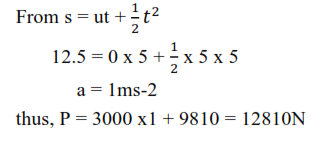
Example 3
A body of mass 5kg is at rest on a rough horizontal plane of coefficient of friction of 0.6. a force of 20 N at 300 above the horizontal is applied on the body. Find
(i) normal reaction
(ii) frictional force exerted by the floor on the body.
Solution

(i) Resolving vertically
R + 20sin 300 = 5g
R = 5 x 9.81 – 10 = 39.05N
(ii) F = μR = 0.6 39.05 = 23.43 N
Motion on an inclined plane
(i) When a body is moving down the slope

Resulting force = mgsinθ –F
ma = mgsinθ –F
but F = μR
and R = mgcosθ
=> ma = mgsinθ –μcosθ
a = g(sinθ –μcosθ)
(ii) when the body is moving up the slope

Resultant force = F + mgsinθ
ma = mgsinθ + F
but F = μR
and R = mgcosθ
=> ma = mgsinθ +μcosθ
a = g(sinθ + μcosθ)
Example 4
A car of mass 0.25 x 103 kg ant a tractive pull of 3450N climbs a truck which is inclined at 320 to the horizontal. The velocity of the car at the bottom of the inclined plane is 27ms-1 and the coefficient of friction between the plane and the car tyres is 0.25. Calculate
(a) distance travelled along the inclined before the car comes to rest.
(b) Time taken before the car comes to rest
Solution

From ma = F – (f + mgsinθ), f = μR = μmgcos320
250a = 3450 – (0.25 x 250x 9.81cos 320 + 250x 9.81sin320)
a = 6.52ms-2
From v2 = u2 -2as
0 = 272-2 x 6.52s
s = 55.9m
from v = u – at
0 = 27 – 6.52t
t = 4.15s
Exercise




Sponsored by The Science Foundation College + 256 753 802709
By Dr. Bbosa Science

I want biology
go to “digitalteachers.co.ug” check under tutorials
i thought that i will find their each and everything about maths A-LEVEL
This is a grt platform but can’t I get a contact number for an Economics teacher specificall you? ?
Helping
You have a way with words, truly. Sports Fitness & Outdoor
You always make things easy to understand. Top adult movies